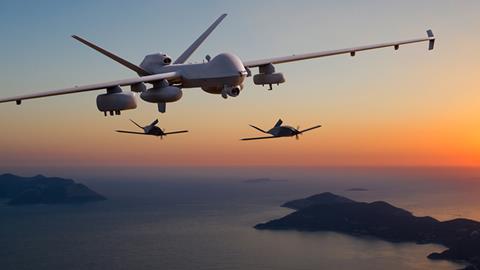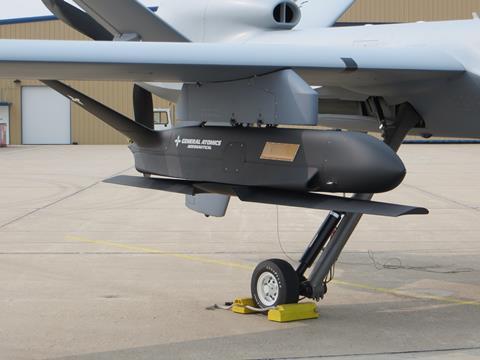General Atomics Aeronautical Systems is teasing a new air-launched effect, a part of a growing portfolio of in-development drones that it plans to launch from its MQ-9A Reaper and MQ-1C Gray Eagle unmanned air vehicles (UAVs).
The company released a digital rendering of two UAVs flying slightly behind an MQ-9 in a promotional tweet for the Special Operations Forces Industry Conference on 19 May. The small unmanned aircraft appears to be propeller-driven and have a v-tail. General Atomics confirms to FlightGlobal that the pictured UAVs are so-called air-launched effects, meaning a type of drone designed to launch from other aircraft or UAVs.

“This rendering represents the first public look at one of our new, unannounced prototypes, which has been in development for some time,” says the manufacturer. “As a whole, our [small unmanned air systems and air-launched effects] family of systems presents a great opportunity to extend the capabilities of the MQ-9 and MQ-1C for the future fight.”
The company is already using internal funds to develop a jet-powered air-launched effect, called Sparrowhawk, that is intended to be air-launched from and air-recoverable by the US Air Force’s MQ-9. The firm told FlightGlobal in 2019 that it planned to develop a family of air-launched effects for a variety of roles, such as intelligence, surveillance and reconnaissance (ISR), loitering munition, anti-radiation missile or electronic warfare applications.
General Atomics declines to name the new air-launched effect, disclose its specific mission or potential customer. However, it notes that the drone type would extend the reach of larger UAVs.
“Our larger aircraft can transport these small [unmanned air systems] thousands of miles into the operational area, and provide the long-range sensors needed to identify potential targets of opportunity,” says the company. “Once identified, the small [unmanned air system] can swoop in for a closer look, provide positive ID, and then track hostile actors.”
That ISR data could then be passed back to an MQ-9 or MQ-1C, and then transmitted onto other nodes in a network, it says.

Designed for counter-terrorism and counter-insurgency missions, the Reaper and Gray Eagle are increasingly vulnerable to being shot down by fighter aircraft and surface-to-air missile batteries fielded by sophisticated foes, such as China and Russia. Long-range air-launched effects are seen as a way to keep the large UAVs outside the weapons engagement zone of US adversaries, thus keeping the aircraft relevant for more years.
“By employing these smaller [unmanned air systems], Reaper and Gray Eagle operators will be able to penetrate, disintegrate and exploit anti-access and area denial air defences, and support operations in any domain,” the company says. “Meanwhile, the greater standoff afforded by these smaller [unmanned air systems] increases the survivability of the larger aircraft by placing them outside the kinetic range of tactical surface-to-air missiles.”
“Some will extend the sensor capabilities of our larger aircraft, and some will provide kinetic effects of their own,” General Atomics adds.
General Atomics says it plans to move quickly with its in-development air-launched effects. The company points out that an MQ-9A conducted captive carry tests of a Sparrowhawk last September. In June 2020, the company demonstrated the MQ-1C’s ability to carry and launch Area-I Altius-600 drones. Other small UAVs and air-launched effects in development, including the recently unveiled UAV, are expected to fly in 2022, the firm says.































